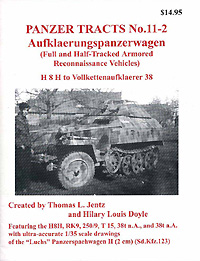| |
Panzer Tracts no. 11-2
Aufklaerungspanzerwagen (Full and Half-Tracked Armoured Reconnaissance
Vehicles) H 8H to Vollkettenaufklaerer 38
by Thomas L. Jentz and Hilary
Louis Doyle
Panzer Tracts, ISBN 0-9744862-2-1, 84 pages

H 8 H, I hear you say, what’s that? Actually a rear-engined half-track
with the suspension of the SdKfz 251; but only a few were built, so it’s
not surprising that it is hardly known. Slightly less obscure are the
Saurer wheel-and-track vehicles, and one of these designs was intended
as a reconnaissance vehicle though, again, few were built – hot-climate
tests showed that temperatures could reach 180 F (82 C) at the driver’s
feet so it’s not surprising that this one didn’t go into service.
Both these types are described and shown in photographs.
Next is the SdKfz 250/9, described in text and shown in photographs
of both “Alte” and “Neue” body types. Modellers
will find this section very helpful; it even includes photos of the interior
arrangements and external stowage, with captions, from the vehicle handbook.
There’s no excuse for getting your model wrong now! After this comes
the celebrated Luchs, or Pz II ausf L if you insist. Text with all the
known unit allocations, photographs (including one showing just how clogged
with mud the suspension could get) and true 1/35 scale plans. I was there
when they did some of the measuring for these plans, and can vouch for
the trouble taken to get all dimensions exactly right. Then there’s
a Luchs variant with sloped armour, a real challenge for modellers as
a conversion from one of the older available kits now that the new Bego
one has lifted the bar for builders of the normal type. The real thing
was a one-off conversion from Luchs V29, and was fitted with a Tatra air-cooled
engine and a modified turret. No plans for that one, alas, but keen modellers
will be able to work out enough to do the job from the four photos included
here.
Next is the Skoda T 15, an unsuccessful design rejected by the army
after testing. Among other “delights” the driver had to sit
crooked to get into it at all. Only a little more successful was the Pz
38t neue Art, with a kit available if you want to model it. 5 were built,
but testing ended in January 1943 without its adoption for service.
Following that we have the Panzerspaehwagen 38t a.A, SdKfz 140/1, and
again with a kit available. The description includes known unit allocations,
with only 5 vehicles unaccounted for of the 70 built. To end the book
there are photographs of the full-scale models of two versions of it modified
to mount the 7.5 cm Kanone L/24, and of the Bergepanzerwagen 38 converted
to mount the same gun.
This is another essential addition to any reference collection on German
WW2 tanks. Only one set of plans, but what a feast of information! Very
highly recommended.
John Prigent
|
|